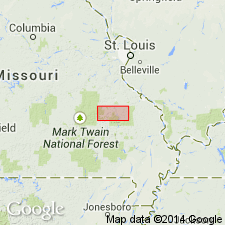
- Usage in publication:
-
- Glover formation
- Modifications:
-
- Named
- Dominant lithology:
-
- Trachyte
- AAPG geologic province:
-
- Midcontinent region
Summary:
Named as an informal field term. [Rank term "formation" should not be used after geographic name for informal units.] Derivation of name not discussed. Mapped in Ketcherside Mountain area in southern St. Francois Mountains, southeast MO, Midcontinent region. Consists of dark maroon, porphyritic, quartz-alkali trachyte with phenocrysts of white perthitic orthoclase (6.3%) and quartz (1.5%). Characterized by an inhomogeneous matrix containing flow bands, lithophysae, and spherulites. Matrix is commonly recrystallized and has pods of secondary quartz giving rock a quartz-rich appearance. Probably represents a lava flow. Overlies Little Creek formation (new, informal field term) [rank term "formation" should not be used after geographic name for informal units]; underlies Ketcherside Mountain ignimbrite (new, informal field term). Glover and Little Creek replace Royal Gorge Rhyolite (not used) of Tolman and Robertson (1969). Table 1 compares nomenclature used in area. Detailed petrographic description in Appendix 1. Precambrian age.
[Authors' intentions are unclear as to which, if any, of the geologic units discussed should have formal status.]
Source: GNU records (USGS DDS-6; Denver GNULEX).
For more information, please contact Nancy Stamm, Geologic Names Committee Secretary.
Asterisk (*) indicates published by U.S. Geological Survey authors.
"No current usage" (†) implies that a name has been abandoned or has fallen into disuse. Former usage and, if known, replacement name given in parentheses ( ).
Slash (/) indicates name conflicts with nomenclatural guidelines (CSN, 1933; ACSN, 1961, 1970; NACSN, 1983, 2005, 2021). May be explained within brackets ([ ]).

